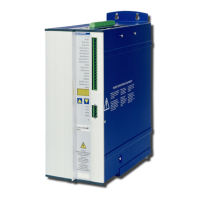3.4.5.6 Abort SDO Protocol
The Abort SDO protocol breaks off SDO transmission, and indicates the error that caused the break
in transmission through an abort code (error code). The error code is in the format of an
UNSIGNED32 value. The following table shows possible reasons for an abort SDO.
Abort Code Description
0601 0000
h
Unsupported access to this object
0601 0001
h
Attempted read access to a write-only object
0601 0002
h
Attempted write access to a read-only object
0602 0000
h
Object does not exist in Object Dictionary
0604 0041
h
Object cannot be mapped to a PDO
0604 0042
h
Size and number of mapped objects exceed permissible PDO length
0604 0043
h
General parameter incompatibility
0607 0010
h
Data type incompatible, length of service parameter is incompatible
0609 0011
h
Subindex does not exist
0609 0030
h
Outside value range for the parameter (only for write access)
0609 0031
h
Parameter value too high
0609 0032
h
Parameter value too low
0800 0020
h
Data cannot be transmitted or saved
0800 0022
h
Data cannot be transmitted or saved because of device status
FF03 0000
h
OS cmd buffer full
Abort Codes not listed above are reserved.
3.4.6 Process Data Object (PDO)
PDOs are used for real-time data communication. PDOs can, for instance, be used to set up con-
trollers similar to analog drives. Instead of +/-10VDC setpoints and ROD feedback, digital speed
setpoints and position feedback are attained via PDOs in this case.
Transmission is carried out unconfirmed without a protocol "overhead”. This communication object
uses the unconfirmed communication service.
PDOs are defined via the Object Dictionary for the S300/S700. Mapping is made during the configu-
ration phase, with the help of SDOs. Length is defined with the mapped objects.
The definition of the PDO service and protocol can be found in DS301. Examples of the usage of
PDOs can be found in the appendix from page 115.
Basically, two types of PDOs can be distinguished, depending on the direction of transmission:
l
Transmit-PDOs (TPDOs) (S300/S700 Þ Master)
The TPDOs transmit data from S300/S700 to control system
(e.g actual value objects, instrument status).
l
Receive-PDOs (RPDOs) (Master Þ S300/S700)
The RPDOs receive data from control system to S300/S700
(e.g setpoints).
S300/S700 supports four independent PDO channels for each direction of transmission. The chan
-
nels are labeled by the channel numbers 1 to 4.
There are two parameter sets each for the configuration of each of the four possible PDOs, and
they can be set up through the corresponding SDOs:
1. Mapping parameters, to determine which data are available (mapped) in the selected
PDO and to define, which data are contained (see pages 52 and 54 ).
2. Communication parameters, that define whether the PDOs operate in synchronized mode,
or event-driven (objects 1400
h
to 1403
h
, 1800
h
to 1803
h
).
22 CANopen for S300/S700
CANopen communication profile 11/2018 Kollmorgen

